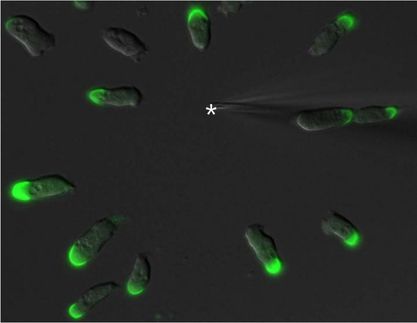Cells help viruses during cell entry
adenoviruses cause numerous diseases, such as eye or respiratory infections, and they are widely used in gene therapy. Researchers from the University of Zurich have now discovered how these viruses penetrate the cells, a key step for infection and gene delivery. The cell unwillingly supports virus entry and infection by providing lipids that are normally used to repair damaged membranes.
An intact cell membrane is essential for any cell to function. The external cell membrane can be damaged by mechanical stress, for example in muscle cells, or by pathogens, such as viruses and bacteria. Membrane damage can result in small pores, which lead to loss of valuable substances from the cell. The cell can quickly repair such injuries to its membrane. Human adenoviruses also cause small pores in the cell membrane, as a team of cell biologists headed by Urs Greber, a professor at the Institute of Molecular Life Sciences at the University of Zurich, has now discovered. These pores are too small for the virus to get directly into the cell but are large enough for the cell to recognize them as a danger signal and repair them in a matter of seconds. The adenovirus uses this very repair mechanism to trigger an infection.
Certain lipids help the virus to enter the cell
During this repair process, lipids – in particular ceramide lipids – are formed, which enable the virus to enter the cell more rapidly. The ceramide lipids cause the membrane to bend and endosomes to form. Endosomes are small bubbles of lipids and proteins and they engulf extracellular material, such as nutrients, but also viruses. With the aid of the ceramide lipids, the virus increases the size of the membrane lesions, and can leave the endosome before the endosome becomes a lysosome and degrades the virus. The virus then multiplies in the nucleus and subsequently infects other cells. “We have identified particular cellular lipids as key components for the virus to enter into cells, which is surprising as lipids have important roles in biology, but these roles are difficult to identify,” explains Stefania Luisoni, the first author on the study and a doctoral student at the Institute of Molecular Life Sciences.
The scientists identified a connection between the formation of a membrane pore by the virus and a cellular repair mechanism. These events form a positive feedback loop, which is part of the explanation for the high infection efficiency of the adenoviruses, which scientists have known for some time. The work also identified a new inhibitor against the adenoviruses, which inhibits the cellular protein “lysosomal acid sphingomyelinase“, and blocks the formation of ceramide lipids in the plasma membrane. “Our results are potentially interesting for the development of new anti-viral agents, and they increase our understanding in how the adenovirus works in vaccination and gene therapy” concludes Greber.
Original publication
Most read news
Other news from the department science

Get the life science industry in your inbox
By submitting this form you agree that LUMITOS AG will send you the newsletter(s) selected above by email. Your data will not be passed on to third parties. Your data will be stored and processed in accordance with our data protection regulations. LUMITOS may contact you by email for the purpose of advertising or market and opinion surveys. You can revoke your consent at any time without giving reasons to LUMITOS AG, Ernst-Augustin-Str. 2, 12489 Berlin, Germany or by e-mail at revoke@lumitos.com with effect for the future. In addition, each email contains a link to unsubscribe from the corresponding newsletter.





















































